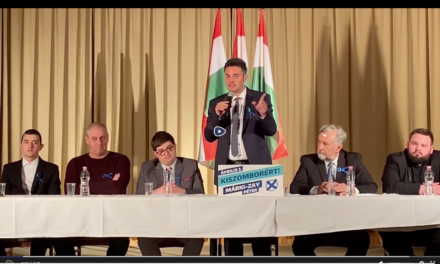Following Putin's speech at the International Economic Forum in St. Petersburg, a 15-point, comprehensive peace proposal was first published in the
in the columns of The National Interest
It has been more than a hundred days since Russia invaded Ukraine, yet we have yet to see the end of the war, which could drag on for months, if not years, leading to the deaths of tens of thousands more and the destruction of cities, further exacerbating the humanitarian crisis. This war resulted in the largest refugee crisis since the end of World War II, with an estimated five million Ukrainians fleeing the country and another eight million displaced within Ukraine. These are staggering numbers, which mean that more than a third of Ukraine's citizens have been forced to leave their homes so far. Ukrainian President Zelensky recently stated that Russian forces currently control 20 percent of Ukraine's territory.
While the Western press continues to falsely claim that Ukraine can win this war, Defense Secretary Lloyd Austin has indicated that Russia is gradually moving toward achieving its military goals. According to a recent Western intelligence report, despite the fact that the United States gives Ukraine four to five times more military aid each year than Kiev spends on its armed forces, Ukraine is losing the battle in the Donbass and suffering "extreme casualties." Ammunition is running out, the troops are becoming more and more demoralized, many are deserting. The strike capability of the Ukrainian artillery is limited to a range of twenty-five kilometers, while that of the Russians is twelve times that. They also found that Ukraine's bargaining position was weakened because Russia has more than ten times as many prisoners of war as Ukraine. The intelligence report concluded: "It is clear that a conventional war cannot be won with less ammunition and less ranged weapons than the enemy."
While acknowledging the risk of Russian nuclear escalation, Joe Biden recently clarified that the United States does not seek direct war with Russia, nor does it support the overthrow of Putin. After declaring last month that his goal was to weaken Russia and destroy its war-fighting capability, he now says that US military aid is aimed at strengthening Ukraine for a more favorable peace.
Asked whether Ukraine might have to hand over part of its territory as part of the peace deal with Russia, Biden did not rule out the possibility.
In the following 15-point peace proposal
the best and most realistic terms that Ukraine could hope for.
Such a negotiated compromise could be brokered by France, Germany, Italy, Turkey and Israel, followed by the cessation of all military operations and the withdrawal of all Russian military forces from Ukraine outside of the Donbass region. The proposal also addresses Russia's most pressing security concerns while serving to enhance the security of NATO members by reducing the chances of future conflict with Russia.
- Ukraine amends its constitution to become permanently neutral. Its independence, neutrality, national sovereignty and territorial integrity are guaranteed by the permanent members of the United Nations Security Council, subject to Ukraine's compliance with the terms of the peace agreement. In return, Russia recognizes the legitimacy of the Ukrainian government and renounces its intention to replace the current leadership with a pro-Russian one.
- Ukraine recognizes Russia's 2014 reunification of Crimea and renounces any intention to retake it by force or otherwise.
- Russia withdraws all its military forces, including Kharkiv, Zaporizhia, and Kherson Oblasts, except for the Donbass region, where the new line of control between Russia and Ukraine is adjusted to the border that existed at the time of the peace.
- By September 2022, a referendum will be held in the entire Donbass region, including Luhansk and Donetsk Oblasts, on whether their citizens wish to become independent or return to Ukrainian control. The referendum is organized by the governments of Luhansk and Donetsk counties with the presence of the UN or another neutral international organization. In the event that the majority of their citizens vote to remain in Ukraine, the region will be permanently demilitarized, with the withdrawal of all Russian and Ukrainian troops. The former Minsk II. in order to guarantee the rights of the Russian-speaking (and other - ed.) However, if the Donbass region votes for independence, all Ukrainian troops must be withdrawn. Russian troops can only stay if the governments of the Luhansk and Donetsk Republics invite them to do so. Regardless of the outcome of the referendum, Ukraine agrees to make Russian its official language again.
- Russia supports Ukraine's application to join the European Union.
- Ukraine permanently suspends its relationship with NATO (military training, joint military exercises, NATO arms shipments, except for small arms), and also prohibits the stationing of NATO troops and the establishment of bases on its territory. Ukraine also agrees to end its membership in NATO's Partnership for Peace program and terminate its November 2021 Strategic Partnership Agreement with the United States.
- It will reduce Ukraine's ground forces to no more than 150,000 active-duty troops and no more than 100,000 reservists.
- Ukraine undertakes to destroy all its "strike systems" under Russian supervision, and expressly prohibits the development or acquisition of weapons systems. But it must also ban the development of weapons of mass destruction, including nuclear and biological weapons, or chemical weapons, and shut down all twenty-six U.S.-funded biological research laboratories within six months of signing the deal and allow Russian inspectors, to enter the laboratories and ensure their closure.
- All prisoners of war, refugees and civilian detainees must be returned to their home countries in accordance with the provisions of the Geneva Convention.
- Neither side pays reparations or goes to an international court for war crimes.
- The United States and the European Union agree to provide economic support for the reconstruction of Ukraine.
- Following the signing of the agreement, diplomatic relations will be restored both between Russia and Ukraine and between Russia and NATO countries.
- Following the implementation of the agreement by both parties, economic sanctions against Russia must be immediately lifted and all seized (public and private) assets and economic assets must be returned to their Russian owners, provided Russia complies with the terms and the parties agree to in the normalization of trade relations within 12 months of signing.
- The United States and NATO provide written guarantees that NATO will never expand eastward into additional former Soviet republics or along Russia's borders (ie Finland). Therefore, in exchange for the guarantees, Russia agrees to Sweden's accession to NATO, as well as the admission of any other European country that does not border Russia and wishes to join the alliance.
- Russia and NATO agree to begin discussions on Russia's inclusion in Europe's security architecture, renew the Intermediate-Range Nuclear Forces (INF) Treaty, and negotiate a Conventional Forces in Europe (CFE) treaty. The agreement following the CFE treaty will reduce the number of American, Western European NATO and Russian troops and bases in Eastern Europe. This includes all nations that joined NATO after 1999, as well as Belarus and Ukraine, and reduces troop numbers on both sides below 9,000. This agreement stipulates that if Russia reduces or eliminates its military presence in Belarus and honors the terms of the peace agreement with Ukraine, the United States and Western European NATO members will also reduce or eliminate their troop bases in the Baltics. states, Poland, Romania, Hungary and Slovakia, making the withdrawal of Russian troops from Belarus proportionate. All of this potentially returns Eastern Europe to the status quo before the July 2016 Warsaw summit.
Advantages
If the Donbas region votes for independence, it would mean the loss of about 6.5 percent of the Ukrainian territory it held before the Russian invasion. However, most of the coastal territory that Ukraine would regain from the peace deal would compensate for Kiev's loss.
Given that Kiev has no real hope of recapturing lost territory militarily, it would have much to gain from a "land for peace" deal.
A negotiated peace will save the lives of thousands, if not tens of thousands, of Ukrainian citizens, spare their cities from further destruction, and allow the rebuilding of roads, bridges, schools, and hospitals. The cost of reconstruction is estimated at 600 billion dollars. Although the war has closed half of Ukraine's businesses, the peace deal could allow them to reopen and millions of Ukrainians to return to work. It would also end Russia's naval blockade of the Black Sea and restore Ukraine's international trade while allowing most of the nearly 13 million refugees to return home.
Finally, an early end to the war would prevent Ukraine's gross domestic product from falling by 60 percent; this is what would happen if the war continued until the end of the year. It is in the national security interest of the United States to encourage warring parties to negotiate peace as soon as possible and to avoid the use of Russian tactical nuclear weapons against Ukraine or other NATO frontline states.
The post-peace lifting of sanctions would also likely bring economic relief to Americans with significant reductions in fuel, food and energy prices. But it would also reduce the severity of the global food crisis, which threatens millions of people in vulnerable countries.
Ukraine's negotiating position will be weaker the longer it delays negotiated peace (ie, the later the Biden administration and its NATO allies talk about it), as its military and territorial losses continue to mount.
If Zelensky decides not to negotiate peace, he could lose the entire Donbass region and Kherson Oblast, while Putin would keep 70 percent of the Black Sea coast, he has made clear. And one of the Russian generals also stated that Moscow will launch an offensive to capture Odessa, thereby cutting off Ukraine from the Black Sea and further weakening the country's economic and territorial security. Based on all of this, it is in the national interest of both the United States and Ukraine to finalize the peace ending the war as soon as possible.
***
Pyne's writing is remarkable in several ways. On the one hand, it makes it clear that the Russian side's "winning streak" is permanent, so much depends on the timing of the peace deal. We can also feel that, although the "offer" seems fair to the Russians at first glance, it would actually keep areas in Ukrainian hands that are currently being fought over, and with a good chance of falling into Russian hands soon. Finally, as an aside, he acknowledges the existence of biological research laboratories maintained by the Americans, which caused intense (etymological) debates in the USA at the beginning of the war. This article was nevertheless born, the editor approved it, the editor-in-chief let it go, and even days after its publication it led the portal's reading list.
Photo: Russian Ministry of Foreign Affairs / Alexander Kryazhev/POOL/TASS













